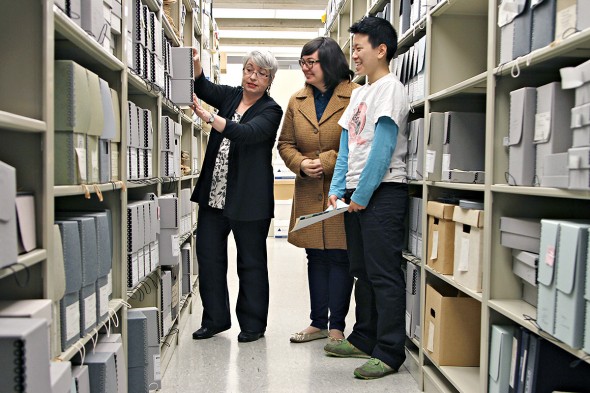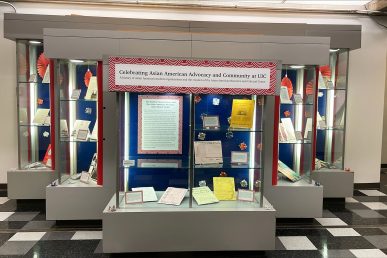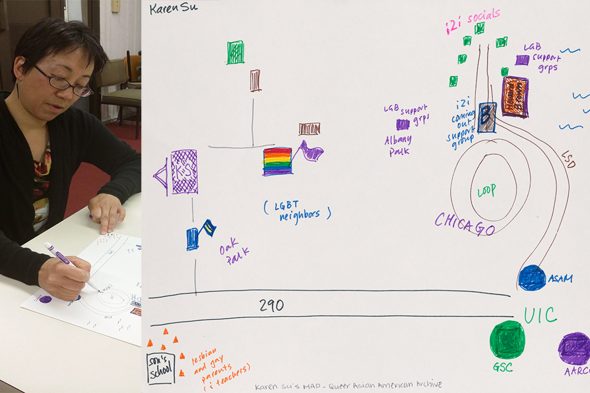Course helps build library’s Queer Asian American Archives

Students in Karen Su’s Asian American Gender and Sexual Diversity course will have an opportunity this spring to assist in gathering oral histories that are part of the Queer Asian American Archives housed at the Richard J. Daley Library at the University of Illinois Chicago.
The class is an introduction to diverse perspectives and experiences of gender and sexuality across various Asian American social, historical and political contexts and communities, with special attention to Chicago.
“The objective is for students to understand how to think about gender and sexuality as components of Asian American identity but also to learn about the histories of the Asian American queer community and look at different ways that the knowledge around those communities are produced, like oral histories,” said Su, clinical assistant professor and director of undergraduate studies in the department of global Asian studies in the College of Liberal Arts and Sciences.
The 200-level class, which is cross-listed in global Asian studies and gender and women’s studies, utilizes the Queer Asian American Archive collection, which is held in the library’s special collections. The archive is one of the only collections that documents the stories of lesbian, gay, bisexual, transgender, queer, asexual, intersex, and gender-nonconforming Asian American, Pacific Islander and South Asian communities in Chicago, UIC librarians said.
The Queer Asian American Archive is a collaboration between UIC’s global Asian studies program and the community organization Invisible 2 Invincible: Asian & Pacific Islander Pride of Chicago. The archive was founded in 2014 by former UIC professor Laura Fugikawa and Liz Thomson, who previously worked at the UIC Gender and Sexuality Center and the Asian American Resource and Cultural Center.
Undergraduates involved since archive’s beginning
Over the years, undergraduate students have collected oral histories for the archive and helped to prepare them so they could be used by researchers, students and others, Su said.
“What’s really great is that the students get a sense of not only this archive, but archives across the country and their importance,” Su said. “They get to contribute directly to making this available and possible.”
Currently, 26 oral histories are available online, including an audio recording and written transcript. Many also have other materials, such as a brief biographical sketch, photographs, time codes for the interviews, and hand-drawn maps documenting the interviewer’s personal spatial pathways in the city, said Peggy Glowacki, special collections librarian. The often deeply personal interviews discuss topics such as coming out to family and friends, self-identification, social opportunities in the Chicago region and more.
“It is an important collection because it empowers and informs both the researchers, who will learn from using the collection, and the creators, who were given the opportunity to tell their own stories in their own words and to select materials that they felt were representative of their lives,” Glowacki said.
Funding for the work came from an Asian American and Native American Pacific Islander-Serving Institutions grant through the U.S. Department of Education’s Minority-Serving Institutions program.
“From the beginning, undergraduate students have been involved; they were the ones collecting the oral history interviews and got the experience doing that,” said Thomson, who recently finished their doctoral studies at UIC and is now director of equity, diversity and intercultural programs and assistant vice chancellor of student affairs at the University of Minnesota Morris.
Community-engaged work
When Fugikawa and Thomson began the archive, they looked at it as a community-engaged project that existed by collaborating with special collections, students, educational classes and volunteers. The aim is to document the role the community has played in Chicago so its past can be honored and organizing can continue.
“Before bringing these things together in one spot, it would have been really hard to give a queer Asian history of Chicago, but by putting these things together and the work that people did to curate it, we’re not as dependent on one person holding the knowledge,” said Fugikawa, now an assistant professor in women and gender studies and American studies at Colby College in Maine. “This collection provides some really good cement for people to find this history.”
Liz Haas, a leader of Invisible 2 Invincible who has assisted in gathering information for the archives, said knowing the history of what people have gone through in the community is helpful for many to know they are not alone.
“I just like knowing that people with this knowledge that reaches further back than mine are still in the community, and you can still talk to them and learn from them,” Haas said. “Having this project as the reason to get those stories is nice.”

Student advocacy at center of Asian American Resource and Cultural Center exhibition
In addition to the archives, the library also has an exhibition available highlighting the creation of the UIC Asian American Resource and Cultural Center as it celebrates its 17th anniversary and its recent move to a new location, 723 W. Maxwell St.
The exhibit shows the role UIC student organizations played in advocating for the Asian American Resource and Cultural Center’s creation by pulling from various student organizations and the center’s records within the university archives, said Leanna Barcelona, assistant professor and university archivist. These records illustrate the importance of students and student organizations in advocacy, both on and off campus, and are a vital part of UIC’s institutional history, she said.
The exhibit will be open during the spring semester and in summer session and will be presented in two sections within the library. The third-floor exhibit space draws from records in the University Archives. The forthcoming second-floor exhibit will include student perspectives on how involvement with the center and student organizations has impacted their lives.
“Now that AARCC is reaching its 17th year, it’s important to document its prominent role in the UIC community as one of the cultural centers on campus. We are excited that the UIC library is setting up the exhibition so that students, staff, faculty and other researchers will be aware of and learn about its significant legacy providing services to Asian American students, staff, and faculty as well as others interested in the community,” said Mark Martell, director of the Asian American Resource and Cultural Center.
Information is available about COVID-19 guidelines while visiting the library. Anyone interested in being involved in the Queer Asian American Archive project or being interviewed can email Su at karensu@uic.edu.

